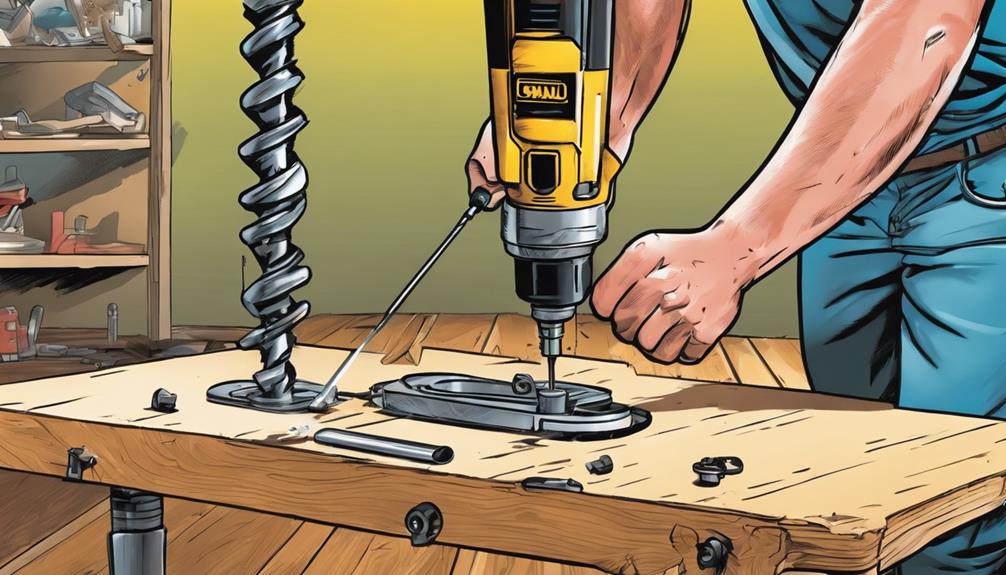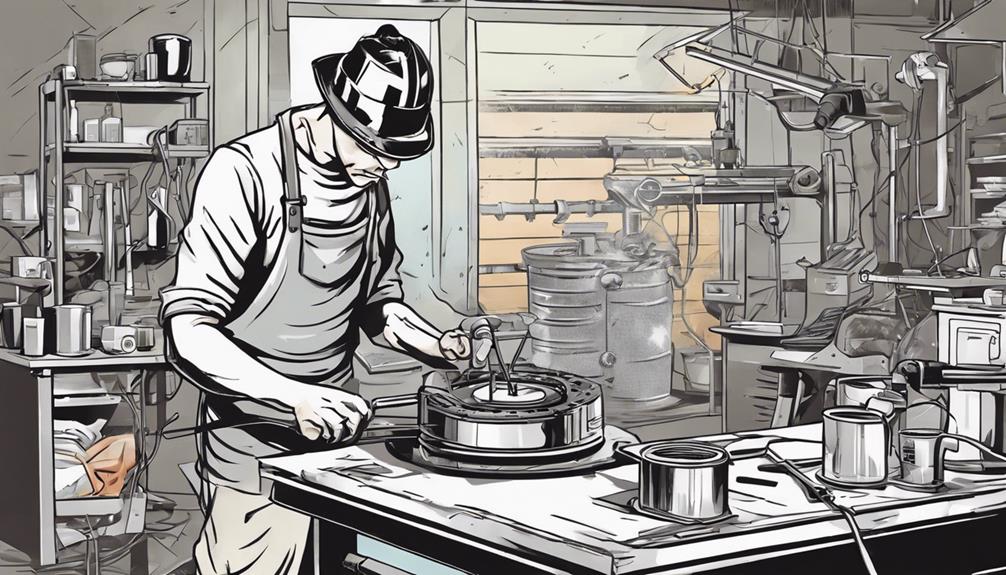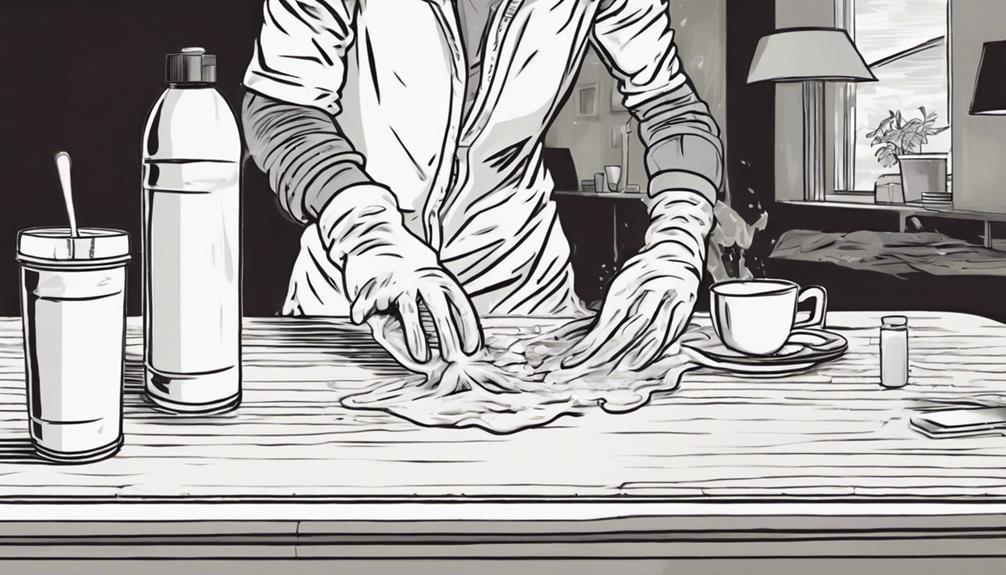To securely attach coffee table legs, think about using surface plates for thinner legs or T-Nuts for easy disassembly. For added stability, consider using mortise and tenon joints or threaded inserts. It is important to measure accurately for a tight fit. Additionally, you can utilize corner braces, metal plates, or pilot holes for a sturdy connection. If you want to learn more ways to ensure your coffee table legs are securely attached for your DIY project, click this link.
Key Takeaways
- Utilize threaded inserts for durable attachment.
- Consider mounting blocks for heavy load bearing.
- Use metal plates for lighter duty applications.
- Directly attach heavier metal legs with screws.
- Choose attachment method based on table size and weight.
Leg Attachment Methods
To attach coffee table legs securely, various methods can be used. Surface plates work well for thinner legs, while T-Nuts are great for tables that need frequent disassembly. Mortise and tenon joints are perfect for large tables needing robust support. Threaded inserts, similar to T-Nuts, offer versatility for different table types.
When using mortise and tenon joints, ensure accurate measurements for a snug fit, creating a strong bond between the leg and the table. Threaded inserts provide a durable connection by screwing into the wood, offering stability and ease of assembly.
Understanding the specific needs of your table and the type of support required will help you choose the most suitable leg attachment method. Proper installation techniques and attention to detail are essential to guarantee a secure and long-lasting attachment for your coffee table legs.
Leg Attachment Techniques

Leg attachment techniques commonly involve using corner braces or metal brackets to securely connect coffee table legs to the tabletop.
When attaching legs with metal brackets, you can cut metal plates to fit into the apron of the table. These plates create strong joints between the legs and the table, enhancing stability.
To guarantee a secure fit, it's essential to drill pilot holes into the legs and tabletop before attaching the metal brackets. This allows for threaded rods or hanger bolts to be inserted, connecting the legs to the brackets effectively.
Commercially-made metal brackets are available, offering a convenient solution for attaching table legs securely. By utilizing these techniques, you can easily assemble and disassemble the table when needed.
Proper leg attachment not only enhances the structural integrity of the coffee table but also facilitates maintenance and transportation.
Incorporating these methods ensures a robust and long-lasting furniture piece.
Table Design Recommendations

Consider integrating steel pins or dowels into the aprons to guarantee proper support for the tabletop weight in your table design. This simple addition can greatly enhance the stability and durability of your DIY furniture project.
Additionally, when using hairpin legs, make sure they're securely attached to prevent wobbling and potential accidents.
When designing your table, keep the following recommendations in mind:
- Use figure 8 connectors or Z-brackets: These hardware options provide a secure attachment point for your table tops, minimizing the risk of detachment or instability.
- Avoid wood splitting: Properly attaching the top to the leg assembly can prevent wood splitting and ensure the longevity of your table.
- Consider incorporating stretchers: Rebuilding the table with a solid leg assembly and stretchers can improve overall stability and weight distribution, making your furniture piece more sturdy.
Table Reconstruction Tips
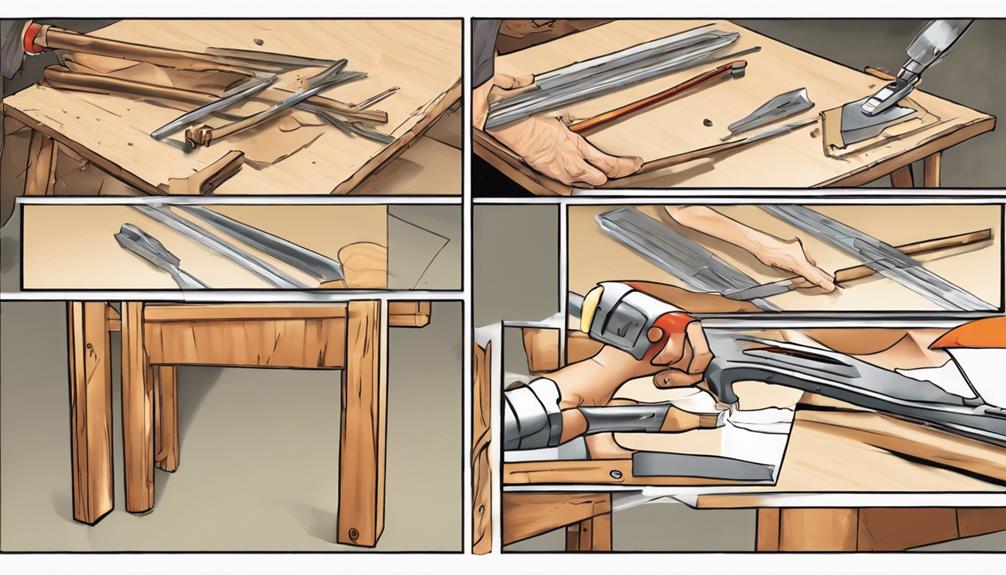
When reconstructing your table, consider incorporating steel pins or dowels into the aprons for improved leg support.
Shaving the inside corner of the leg can enhance stability, especially when using metal braces.
To guarantee a solid leg assembly, attach stretchers for added structural support during the reconstruction process.
Leg Support Techniques
To enhance the stability and longevity of your rebuilt table, focus on reinforcing the leg support with appropriate techniques.
When reconstructing your table, consider the following leg support techniques:
- Attach Corner Blocks: Securing corner blocks to the inside of the table legs can provide additional stability and prevent the legs from shifting or coming loose over time.
- Utilize Figure 8 Connectors: Figure 8 connectors are an excellent choice for attaching the table surface to the legs. These connectors help distribute weight evenly and reduce the risk of the table surface warping or becoming unbalanced.
- Incorporate Z-Brackets: Z-brackets are effective in providing a secure top attachment to the table legs. They offer strong support and help maintain the integrity of the overall structure.
Stability Enhancing Methods
Strengthen the stability of your reconstructed table by reinforcing the leg support with steel pins or dowels added to the aprons for extra support. By incorporating these reinforcements, you can ensure a robust foundation that withstands daily use.
When attaching the legs, consider using a pilot hole to prevent splitting and to create a secure connection. Additionally, rebuilding the table with a solid leg assembly and attaching stretchers can greatly improve stability, preventing wobbling or tilting.
To further enhance the overall structure, utilize figure 8 connectors or Z-brackets for top attachment. These methods not only boost stability but also address wood movement and user interaction issues.
Avoid relying solely on screws and angle brackets, as they may loosen over time and compromise the table's stability. By implementing these stability-boosting methods during reconstruction, you can create a durable and reliable coffee table that lasts for years to come.
Leg Placement Challenges
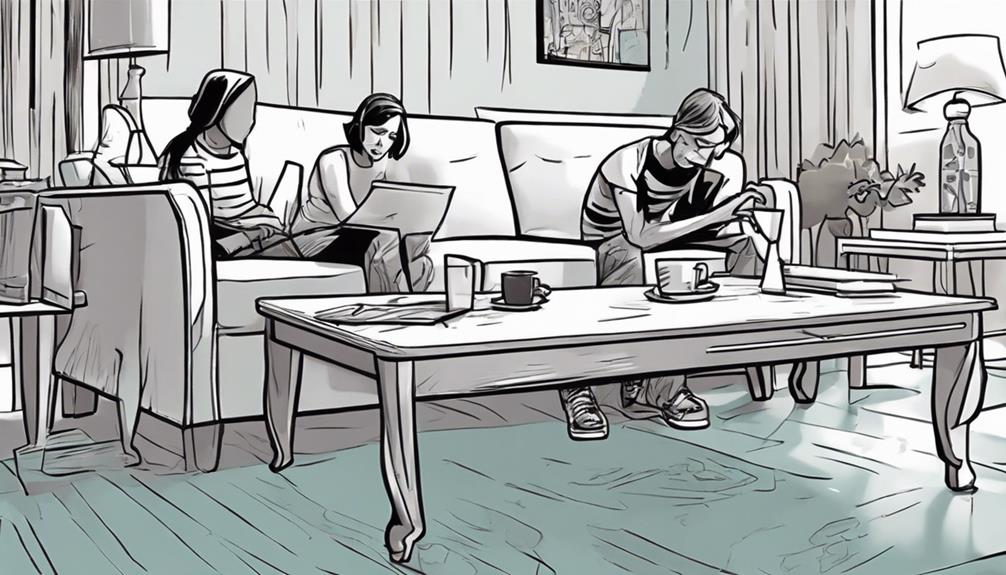
When attaching coffee table legs, you might encounter challenges with leg stability and support. These concerns can be addressed by opting for a supportive leg design that considers the natural movement of wood.
Leg Stability Concerns
Leg stability concerns can be exacerbated by challenges in properly placing the coffee table legs due to the table top's width changes affecting their positioning.
When dealing with leg stability issues, consider the following:
- Anchoring limitations: Attaching legs directly to rails and stiles can restrict movement, potentially leading to stability problems.
- Inadequate support: Loose or wobbly legs may result from poor leg support or inadequate attachment methods, compromising the overall stability of the coffee table.
- Effective support solutions: Incorporating properly designed corner blocks or brackets can provide the necessary support for independent leg assemblies, ensuring a secure and stable attachment.
To address leg stability concerns effectively, it's vital to assess the attachment methods and support structures to prevent wobbling or instability.
Supportive Leg Design
To improve the stability of your coffee table legs, consider adjusting their placement to address challenges posed by the width changes of the tabletop. Leg placement challenges can arise when the width changes of the tabletop affect the legs' stability.
Anchoring legs directly to rails and stiles may restrict movement, leading to wobbly table legs. It's essential to incorporate properly designed corner blocks or brackets to support independent leg assemblies for better stability.
Loose and wobbly legs often result from poor leg support, necessitating frequent retightening of leg bolts. Concerns with table assembly, such as wood splitting, cracking, and poor stability, are typically linked to improper leg attachment methods.
Alternative Construction Methods

Consider incorporating dowels or floating tenons to enhance the stability of your coffee table legs attachment. These alternative construction methods provide a more secure connection between the table base and the legs, ensuring that your DIY furniture piece is strong enough to withstand daily use.
Here are some additional tips to improve the attachment of your coffee table legs:
- Disassemble the table for attaching legs to stretchers to increase stability.
- Utilize dowels or floating tenons to create a solid platform for the table legs.
- Allow for movement between the tabletop and base to prevent wood splitting issues.
Wood Identification Tips

When identifying wood for your coffee table project, examine characteristics such as color, grain pattern, and texture to determine the type of wood you are working with. Different wood species have unique features that can help you distinguish between them. For instance, Jarrah and merbau woods are known for their reddish-brown hues and durability, while mahogany wood features a reddish-brown color with a straight grain pattern. Examining the hardness, weight, and appearance of the wood can also aid in identifying the species you are dealing with. Additionally, observing the original finish and any respiratory reactions when working with the wood can provide further clues for accurate wood identification.
| Characteristic | Jarrah and Merbau | Mahogany |
|---|---|---|
| Color | Reddish-brown | Reddish-brown |
| Grain Pattern | – | Straight |
| Texture | – | – |
Attachment Methods Summary
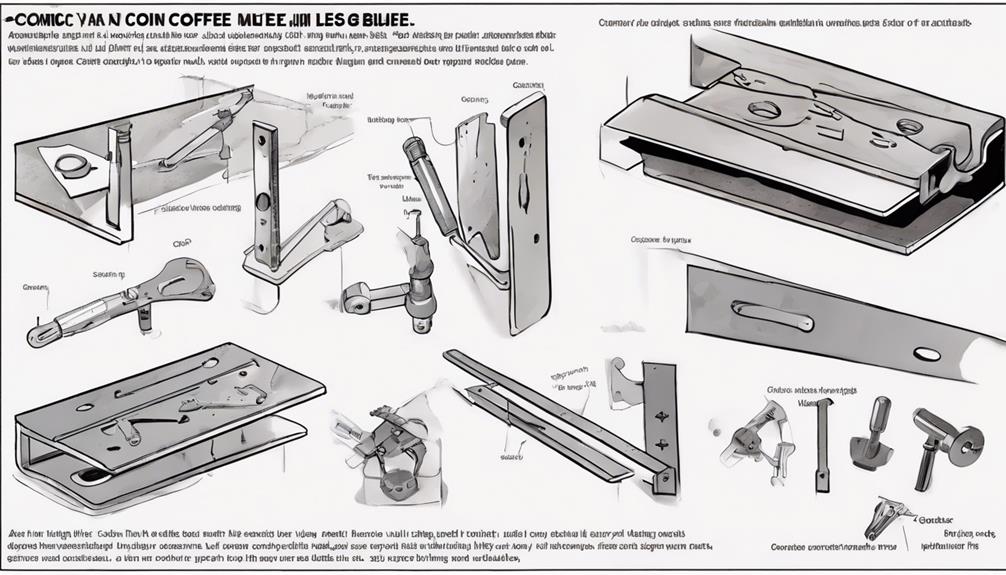
For a secure and efficient way to attach legs to your coffee table, various methods can be employed based on the load bearing capacity and ease of installation desired. One option is to use traditional wood screws or metal brackets to secure the legs to the tabletop. This method provides a sturdy attachment and is ideal for tables that will bear heavier loads. For a more streamlined and modern look, metal hairpin legs can be easily screwed into place. Additionally, attaching bottom shelf to coffee table can be done using L-brackets or pocket hole screws for a seamless and secure connection, providing extra storage space and structural support.
- Straight and Angled Metal Plates: Recommended for lighter duty applications, these plates are attached with 4 screws, providing a simple and effective attachment method.
- Threaded Inserts: Ideal for experienced woodworkers, threaded inserts offer a strong attachment option for most coffee table applications, ensuring stability and durability.
- Mounting Blocks: Suitable for heavy load bearing, mounting blocks come in 7 wood species and are attached with 4 screws, providing a sturdy and reliable attachment method.
Consider the weight and size of your coffee table when choosing the attachment method. For heavier metal legs and larger furniture pieces, direct attachment with screws is a practical choice. Threaded inserts offer a robust option for those seeking a strong attachment, while metal plates are a simpler solution for lighter duty applications.
Expert Q&A
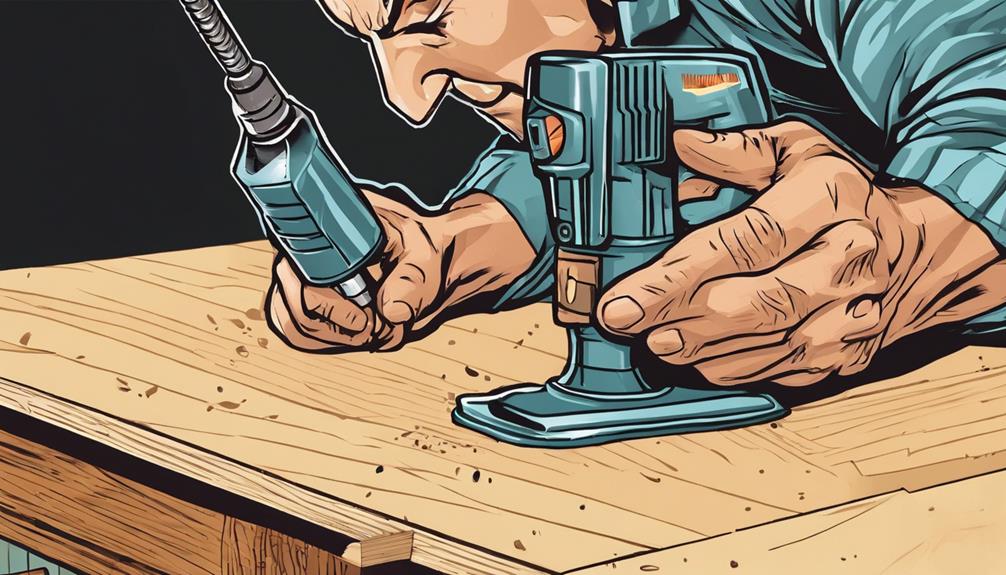
Looking for expert guidance on stabilizing wobbly coffee table legs? Expert Q&A sections provide valuable insights on securing table legs for your DIY projects. Safety precautions are emphasized to guarantee a stable attachment of coffee table legs.
For further assistance, consider reaching out to specialists like Badger Home Repair Service in Portland, known for their expertise in home repair, including table leg attachment. Reader success stories serve as testimonials to the effectiveness of the advice offered in these Q&A sessions.
Specific tips and warnings are shared to help you securely attach coffee table legs, ensuring a robust and durable piece of furniture. By following the expert advice provided in these Q&A sections, you can enhance the stability and longevity of your coffee table, making it a reliable and attractive addition to your home decor.
Frequently Asked Questions
How to Securely Attach Table Legs?
To firmly attach table legs, guarantee stability by using metal plates with screws or threaded inserts. For heavy loads, try angled cleats or mounting blocks. Always pre-drill pilot holes and follow recommended methods for a secure fit.
How Do You Stabilize Coffee Table Legs?
To stabilize coffee table legs effectively, reinforce joints with corner braces or metal brackets, add steel pins or dowels for extra support, attach using figure 8 connectors or Z-brackets, check for placement issues, and avoid screws and angle brackets for lasting stability.
How to Attach Legs to a Table Without an Apron?
To attach legs to a table without an apron, consider using metal plates with screws, threaded inserts for a strong hold, mounting blocks for heavy tables, or straight and angled cleats for easy attachment. Single angled cleats work well for 3-legged tables.
How to Make Stable Table Legs?
To make stable table legs, choose sturdy materials like metal plates or threaded inserts. Guarantee proper alignment and support to avoid wobbling. Consider corner braces or T-Nuts for security. Follow recommended techniques for stability. Seek expert advice for complex projects.
Conclusion
So, now that you've learned how to attach coffee table legs securely, you can confidently tackle your next DIY furniture project. You can also apply the same principles when attaching a bottom shelf to your DIY coffee table. Make sure to measure and mark the placement of the shelf carefully, use the proper tools and hardware, and double check for stability before finishing the project. With these skills under your belt, you’ll be well on your way to creating beautiful and functional furniture pieces for your home.
With these techniques and tips in your toolbox, you'll be able to create beautiful and sturdy tables that will last for years to come.
So go ahead, grab your tools and get started on your next furniture masterpiece – you've got this!
